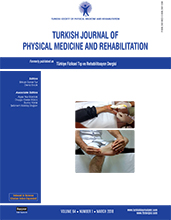The clinical effects of somatotype difference on isokinetic knee muscle strength and dynamic balance scores
2 İnönü University, School of Physical Education and Sports, Malatya, Turkey
3 Department of Physical Medicine and Rehabilitation, Inonu University Faculty of Medicine, Malatya, Turkey
4 Department of Physical Medicine and Rehabilitation, Malatya State Hospital, Malatya, Turkey DOI : 10.5606/tftrd.2017.883 Objectives: The aim of this study was to present the somatotype features of young individuals without any symptoms and to identify whether isokinetic knee muscle strength and dynamic balance scores are affected by somatotype difference.
Patients and methods: A total of 146 participants (88 males, 58 females; mean age 22.5±1.9 years; range 19 to 28 years) who had no symptoms were included in this study. Somatotypes of the participants were calculated using the Heath-Carter formula, and anthropometric measurements were taken from each participant. Knee flexion and extension muscle strengths at angular speeds of 90°/sec, 120°/sec and 150°/ sec were measured from the dominant and non-dominant limbs of the participants. Total balance, anterior/posterior balance, and medial/ lateral measurements were made to evaluate dynamic balance performances.
Results: Six different somatotypes were found. Endomorphic mesomorph was the most common somatotype in 56 participants. There was no significant somatotype difference in men and women for dominant and non-dominant knee extension and flexion peak strength values at angular speeds of 90°/sec, 120°/sec and 150°/sec (p>0.05). No significant difference was found between the balance scores of men and women who had different somatotypes (p>0.05).
Conclusion: Anatomic structure of the body, which is suitable for the sports branch, has an increasing effect on performance.
Keywords : Anthropometry; dynamic balance; isokinetic strength; somatotype
















